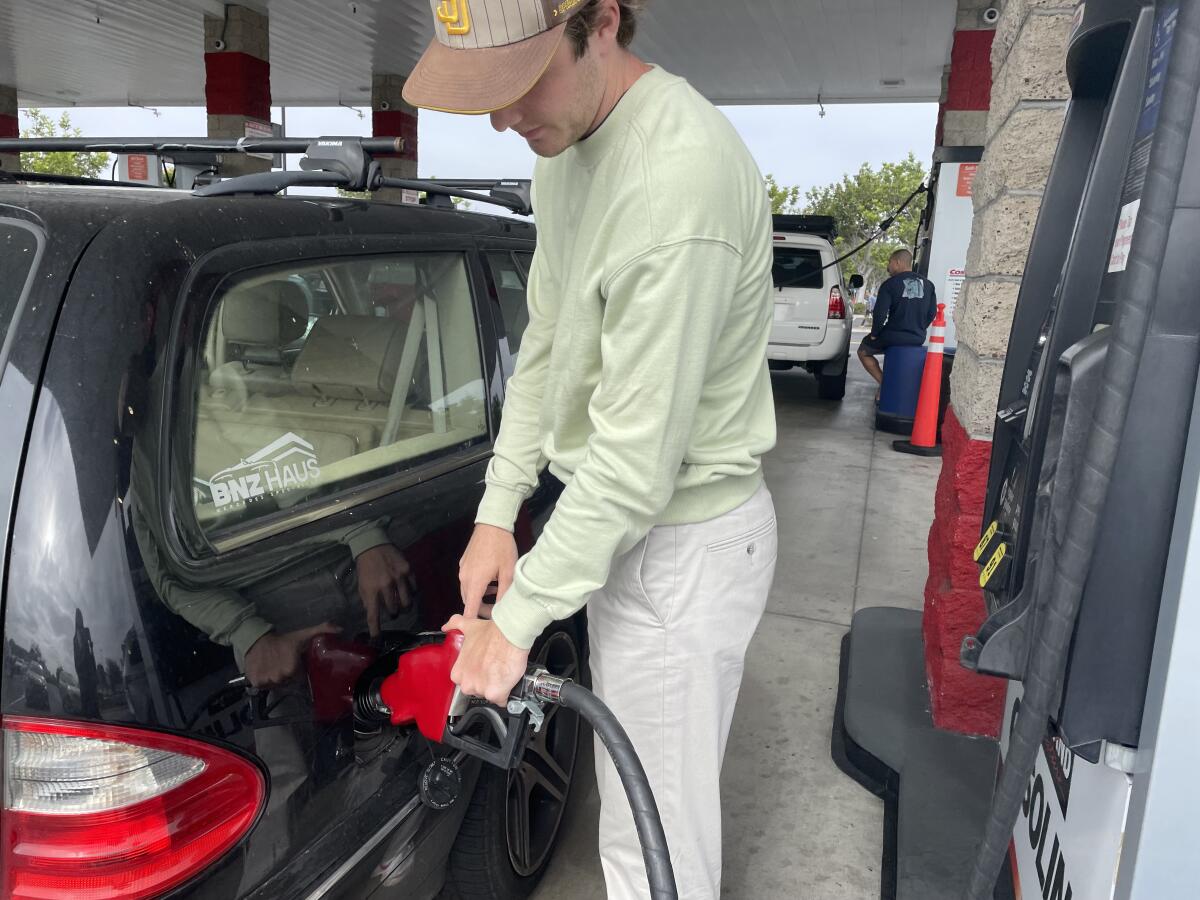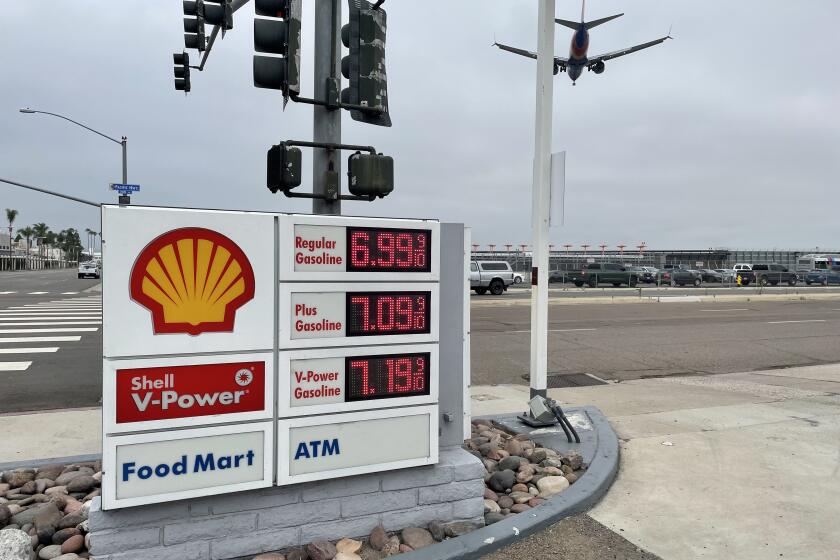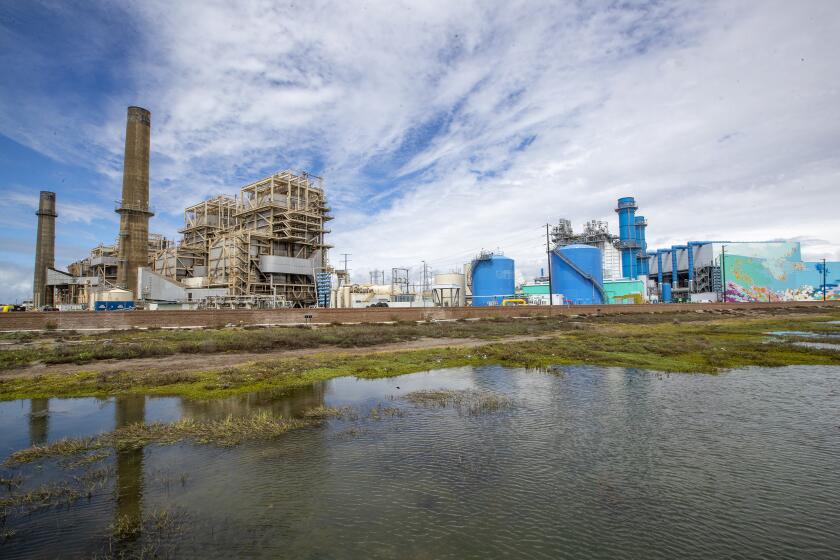Newsom signs state budget bills, with gas refunds to 17.5 million California taxpayers

SACRAMENTO — Gov. Gavin Newsom on Thursday signed into law key elements of a new $307.9-billion state budget, a spending plan centered on gas refunds for 17.5 million taxpayers to soften the sting of high fuel prices and the cost of living.
The refunds, varying from as little as $200 for individuals up to $1,050 for couples with children, are the hallmark of the state’s effort to return a portion of an anticipated $101.4-billion surplus back to Californians. The governor and lawmakers also invested heavily in K-12 public education, directed billions of dollars to secure enough power to keep the lights on during heat waves and earmarked $47 billion for infrastructure projects over the next three years.
“This budget invests in our core values at a pivotal moment, safeguarding women’s right to choose, expanding health care access to all and supporting the most vulnerable among us while shoring up our future with funds to combat the climate crisis, bolster our energy grid, transform our schools and protect communities,” Newsom said in a statement.
The budget covers the 2022-23 fiscal year that begins Friday. It’s a period in which economists warn that the Russian invasion of Ukraine, interest rates and inflation could weaken the U.S. economy and lead to a recession. That would surely dampen the record revenues California has received in recent years largely from income taxes paid by its highest earners.
The spending plan that Newsom and lawmakers approved features a $17-billion relief package to help families, seniors, low-income Californians and small businesses. The package includes $9.5 billion in gas refunds, $1.4 billion in utility payment assistance, expanded tax credits, $250 million for paid sick leave grants, a suspension of the sales tax on diesel fuel at a cost of $439 million to the state and $75 million in drought relief grants.
Newsom and the Legislature disagreed for months over income eligibility for gas refunds and how much Californians should receive, a debate that delayed the timeline to begin delivering payments until October. Many lawmakers wanted to direct more of the surplus to infrastructure funding, which ultimately included a multiyear investment of $14.8 billion in transportation, $2 billion for student housing through 2025, more specific projects in their home districts and other spending priorities.
The governor compromised with lawmakers on the final refund plan, giving up his push to offer money exclusively to drivers. The Legislature agreed to increase the income limits it had initially proposed, while preserving its original intent to give higher payments to families who earn less money.
Gov. Gavin Newsom and leaders of the California Legislature have agreed to provide more than $9 billion in refunds to taxpayers to offset high gas prices and inflation. The deal comes after months of slow negotiations at the state Capitol and disagreement between Democrats over how much relief to offer.
The plan provides refunds on a sliding scale based on three income levels: single tax filers who earn up to $75,000 or joint filers who report as much $150,000, individuals with income up to $125,000 or couples up to $250,000 and single filers who make $250,000, or $500,000 for joint filers.
The lowest income bracket is eligible for $350 per tax filer and another $350 for those who claim at least one dependent. Respective payments drop to $250 for the middle-income level and $200 for the highest.
The plan leaves out the state’s top earners and those at the very bottom who don’t make enough money to file taxes. To help some but not all those who don’t file taxes, the budget boosts Supplemental Security Income grants by about $39 a month for individuals and $100 for couples on Jan. 1. Starting in October, CalWORKs grants for low-income families will also increase by 21%, lawmakers said.
“In any year this would be a great budget,” said Senate President Pro Tem Toni Atkins (D-San Diego). “In a world where we’re facing global inflation and ongoing pandemic issues, this budget is as remarkable and is responsible.”
But as the budget broadens the safety net, anti-poverty advocates said the state can and should do more with its surplus to help its most vulnerable residents, calling for further expansion of eligibility for tax credits and food benefits.
The budget sets aside $1.5 billion over two years in bridge housing for individuals experiencing homelessness and serious mental illness, $300 million in the upcoming year for local government encampment grants and billions toward affordable housing programs. To help first-time home buyers, the budget provides $500 million to establish the California Dream for All program to offer assistance with down payments and lower monthly mortgage costs.
“Even with these important programs, there is still a lot of work to do to uplift disadvantaged communities, to upset the setup and make sure prosperity is ubiquitous,” Assemblymember Isaac Bryan (D-Los Angeles) said last week at the first meeting of the Legislature’s Select Committee on Poverty and Economic Inclusion.
California will become the first in the nation to offer food assistance to immigrants over 55 years old who reside here illegally.
The committee was established earlier this year to focus policy on the state’s widening wealth gap. The state is grappling with a crisis of homeless Californians and the highest child poverty rates in the U.S., when adjusted for cost of living, just as it celebrates the record state surplus.
“These stark differences are hard to tolerate in the fifth-largest economy in the world, in a state with more millionaires and billionaires than anybody else,” Bryan said.
Jerry Nickelsburg, director of the UCLA Anderson Forecast and a professor of economics, said California continues to see fewer jobs in retail, one of several low-income service sectors hardest hit in the 2020 recession, compared with before the pandemic.
“Across the income spectrum, there’s a disparity as to where the pain is,” he said.
The state economy is expected to continue to grow faster than the U.S. in the upcoming year based on strength in logistics, the recovery of the leisure and hospitality sector, the tech industry and an expected increase in demand for construction and infrastructure work, Nickelsburg said.
But California, similar to the rest of the nation, could be vulnerable if the Federal Reserve tightens rates again as expected. If financial markets continue to take a hit, there could be fewer IPOs, stock option exercises and the kinds of bonuses for executives that boost the income of wealthy earners and the state’s income tax revenue, he said.
Nickelsburg said the state’s $37.2 billion in general fund reserves should serve as a backup contingency fund in the event of a limited pullback in the financial markets. State officials expect California’s rainy day fund to increase to $23.3 billion by year’s end.
California will pay down debt, including $1 billion over two years toward a $17.8-billion federal loan that the state used to fill a hole left by a surge in unemployment claims during the worst of the pandemic. The Department of Finance said the budget also estimates supplemental payments to reduce state retirement liabilities of $3.4 billion in 2022-23.
Several lawmakers crowed over investments in education and what they described as a $4.3-billion increase for school districts and charter schools above the cost-of-living-adjustment under the local control funding formula, proclaiming the spending plan would boost California’s abysmal ranking in per-pupil funding.
A controversial budget bill to make it easier to secure emergency electricity supplies received less praise, particularly from environmentalists. Several lawmakers with a track record of supporting climate policies were clearly torn on the measure, acknowledging that it’s imperative for the state to ensure electricity runs during heat waves but lamenting that California will rely on fossil fuels and loosen its environmental protections to do so.
Gov. Gavin Newsom is struggling to keep the lights on while fighting climate change.
The budget also breaks a long stalemate between Newsom and Assembly Democrats over high-speed rail funding. Lawmakers agreed to release $4.2 billion in Proposition 1A funds to the California High-Speed Rail Authority, prioritizing $2 billion for the construction of the Merced-to-Bakersfield segment with a new independent Office of Inspector General providing oversight of the project.
Most of the spending for new programs in the 2022-23 state budget is dedicated on a one-time basis, with a promise of funding for only one year. A downturn could threaten the ability to fund those programs again next year.
Economic turmoil could also jeopardize budget commitments Newsom and lawmakers have pledged to support in the future, such as expansions slated for 2024 of Medi-Cal coverage to all eligible Californians regardless of immigration status and of the Cal Grant financial aid program to make about 150,000 more California college students eligible for state support to cover tuition and living expenses.
“We are in a time of heightened uncertainty,” Nickelsburg said. “There’s more political uncertainty today. There’s more economic uncertainty today and that means that while we are looking for California to continue to grow, albeit at a slower rate than it grew last year, there is more uncertainty about that forecast.”
Times staff writers Mackenzie Mays and Melody Gutierrez contributed to this report from Sacramento. Teresa Watanabe and Sammy Roth contributed from Los Angeles.
More to Read
Sign up for Essential California
The most important California stories and recommendations in your inbox every morning.
You may occasionally receive promotional content from the Los Angeles Times.














